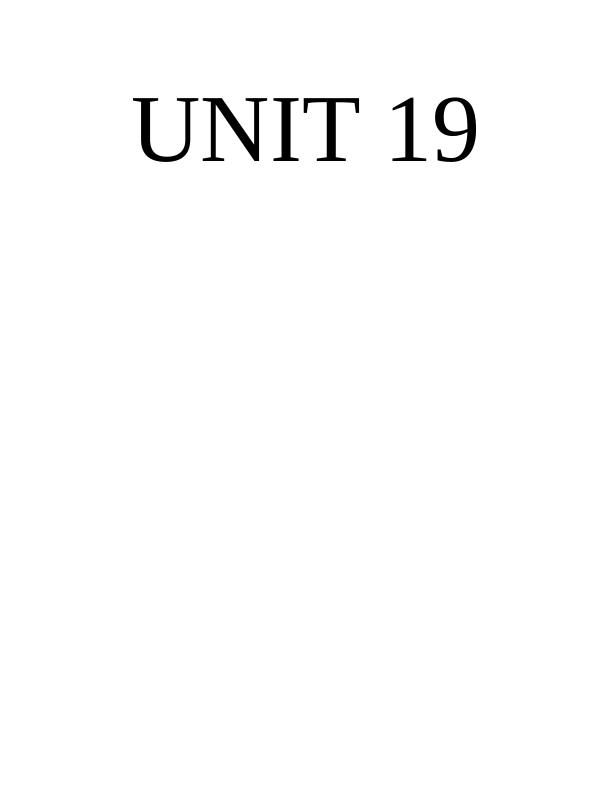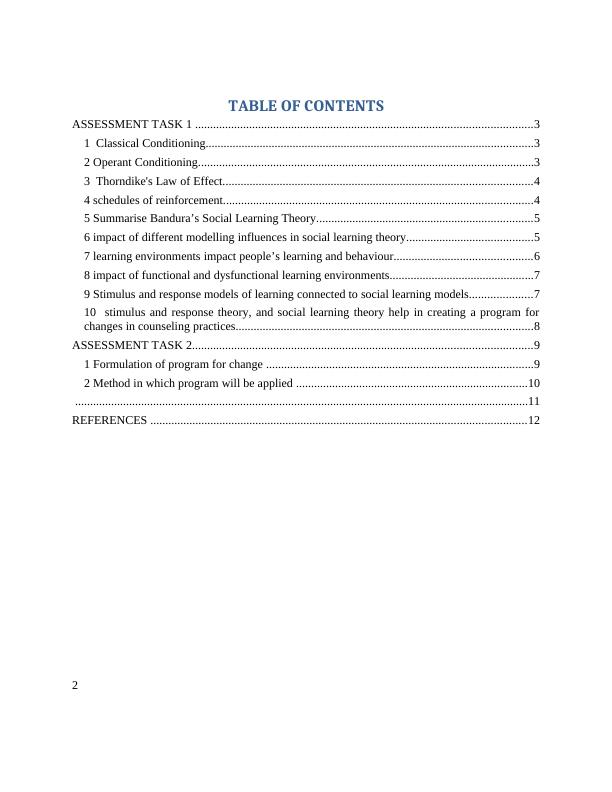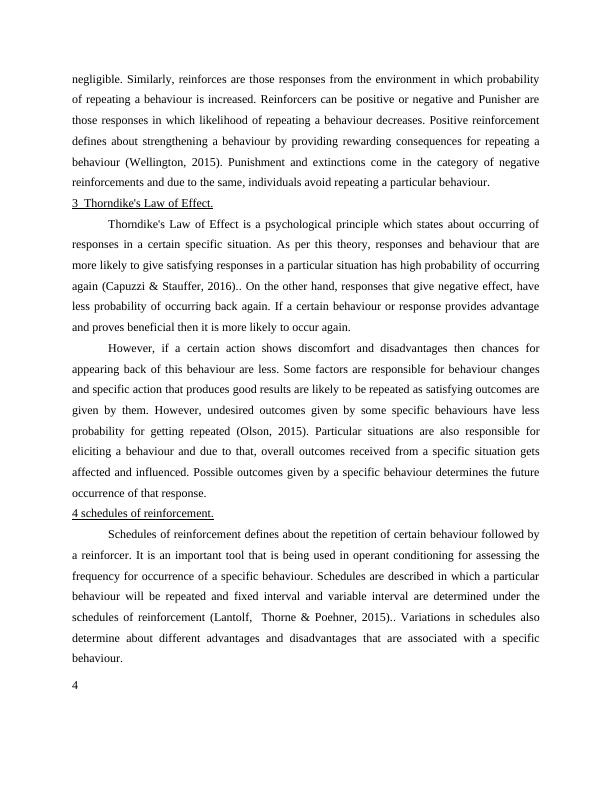Ask a question from expert
Albert Bandura and Social Learning Theory
13 Pages3918 Words278 Views
Added on 2019-12-17
Albert Bandura and Social Learning Theory
Added on 2019-12-17
BookmarkShareRelated Documents
UNIT 19

TABLE OF CONTENTSASSESSMENT TASK 1 ................................................................................................................31 Classical Conditioning.............................................................................................................32 Operant Conditioning................................................................................................................33 Thorndike's Law of Effect.......................................................................................................44 schedules of reinforcement.......................................................................................................45 Summarise Bandura’s Social Learning Theory........................................................................56 impact of different modelling influences in social learning theory..........................................57 learning environments impact people’s learning and behaviour..............................................68 impact of functional and dysfunctional learning environments................................................79 Stimulus and response models of learning connected to social learning models.....................710 stimulus and response theory, and social learning theory help in creating a program forchanges in counseling practices...................................................................................................8ASSESSMENT TASK 2.................................................................................................................91 Formulation of program for change .........................................................................................92 Method in which program will be applied .............................................................................10.......................................................................................................................................................11REFERENCES .............................................................................................................................122

ASSESSMENT TASK 1 1 Classical ConditioningClassical conditioning is a learning theory in which knowledge and information isacquired between a naturally occurring and environmental stimulus. Some assumptions are usedunder classical conditioning and it supports in the overall learning procedure. According toclassical conditioning theory, complete learning occurs through interaction with the environmentand behaviour is also shaped due to the same. Association between external and internal stimulusresults in learned response (Harker, Mahar & Wilkes, 2016).. Initially a naturally occurringstimulus elicits a response and unconditioned stimulus gives response as a result of same. Automatic and responsive responses are included under it and a neutral stimulus is pairedwith an unconditioned stimulus. According to classical conditioning approach, learning occursthrough a systematic approach and process in which response is elicited by external stimuli.Conditioned stimulus is neutral stimulus that starts a response and reflex outcome is given byunconditioned stimulant (External stimulus .2017). Conditioned stimulus gives response towardsthe unconditioned stimulus and predictions are given to unconditional stimulus. Behaviours aremodified through association of stimuli and overall learning process depends upon the same(Talbot-Smith, Abell & Hanuscin, 2013). Conditioned response is generally similar tounconditioned response and Ivan Pavlov gave a theory by conducting study on various stimulus. 2 Operant Conditioning.According to operant conditioning, it has been observed that there are two types ofreinforcements naming as positive and negative. In negative reinforcement, behaviour orresponse given by a stimulus is Strengthened by removing, avoiding and stopping a negativeoutcome. Negative reinforcement is given under an operant conditioning and due to that, itbecomes easier for strengthening the desired behaviour (Bresler, 2013). As per the theory ofoperant conditioning, the best way to understand the behaviour of an individual is to look at theroot cause and consequences received from that behaviour. Intentional actions that give impact on the surrounding environment are main operant andidentification of procedures is done because of which certain behaviour or actions generallyoccur. Neutral operant are those responses in which probability of repeating the behaviour is3

negligible. Similarly, reinforces are those responses from the environment in which probabilityof repeating a behaviour is increased. Reinforcers can be positive or negative and Punisher arethose responses in which likelihood of repeating a behaviour decreases. Positive reinforcementdefines about strengthening a behaviour by providing rewarding consequences for repeating abehaviour (Wellington, 2015). Punishment and extinctions come in the category of negativereinforcements and due to the same, individuals avoid repeating a particular behaviour. 3 Thorndike's Law of Effect.Thorndike's Law of Effect is a psychological principle which states about occurring ofresponses in a certain specific situation. As per this theory, responses and behaviour that aremore likely to give satisfying responses in a particular situation has high probability of occurringagain (Capuzzi & Stauffer, 2016).. On the other hand, responses that give negative effect, haveless probability of occurring back again. If a certain behaviour or response provides advantageand proves beneficial then it is more likely to occur again. However, if a certain action shows discomfort and disadvantages then chances forappearing back of this behaviour are less. Some factors are responsible for behaviour changesand specific action that produces good results are likely to be repeated as satisfying outcomes aregiven by them. However, undesired outcomes given by some specific behaviours have lessprobability for getting repeated (Olson, 2015). Particular situations are also responsible foreliciting a behaviour and due to that, overall outcomes received from a specific situation getsaffected and influenced. Possible outcomes given by a specific behaviour determines the futureoccurrence of that response. 4 schedules of reinforcement.Schedules of reinforcement defines about the repetition of certain behaviour followed bya reinforcer. It is an important tool that is being used in operant conditioning for assessing thefrequency for occurrence of a specific behaviour. Schedules are described in which a particularbehaviour will be repeated and fixed interval and variable interval are determined under theschedules of reinforcement (Lantolf, Thorne & Poehner, 2015).. Variations in schedules alsodetermine about different advantages and disadvantages that are associated with a specificbehaviour. 4

End of preview
Want to access all the pages? Upload your documents or become a member.
Related Documents
Introduction to Psychology: Learning, Classical Conditioning, Operant Conditioning, and Social Learninglg...
|9
|1819
|188
Introduction to Psychology Theory 2022lg...
|10
|2712
|26
Classical Conditioning and Intellectual Deficit - PDFlg...
|12
|2915
|23
(PDF) Approaches to Working with Children and Familieslg...
|7
|1492
|55
Behavioral Perspective Assignmentlg...
|5
|657
|139
Health Behavior and Changelg...
|8
|1749
|175